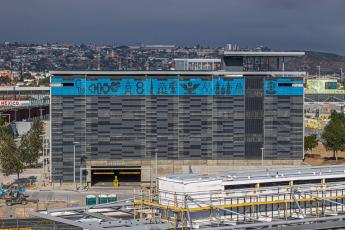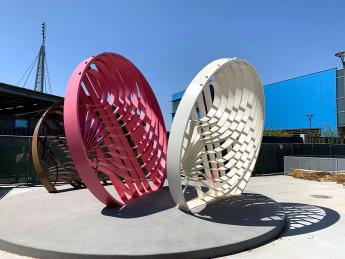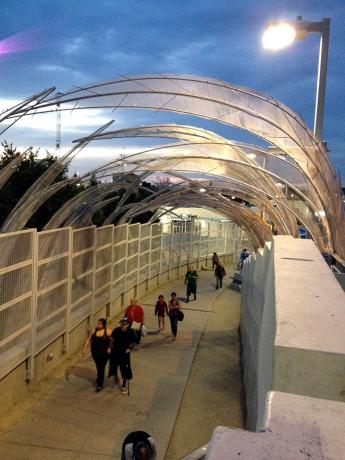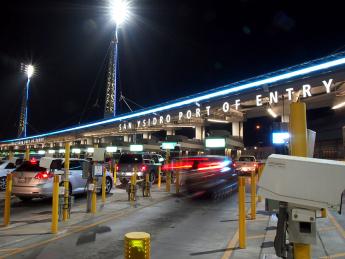Beauty at the Border: A collection of Art in Architecture pieces at the San Ysidro Land Port of Entry
By Javier Fernandez
In 1963, President John F. Kennedy’s ad hoc Committee for Federal Architecture recommended that “fine art should be incorporated in the designs of federal buildings with emphasis on the work of living American artists.” In the years since, the U.S. General Services Administration (GSA) has closely followed the committee’s recommendation and developed a robust Art in Architecture (AiA) program aimed at enhancing the civic meaning of federal architecture through the works of celebrated American artists. In its role as the federal government’s landlord, GSA is proud to create a lasting cultural legacy through public works of art at our federal buildings and facilities for the public and future generations to enjoy.
GSA reserves half a percent of a project’s estimated construction costs of federal construction projects to commission AiA pieces. For a major construction project like the San Ysidro Land Port of Entry (LPOE) modernization and expansion project, GSA was particularly deliberate in selecting artists and commissioning art pieces which embraced the binational region’s history, culture and heritage.
Datum - Ryan McGinness
Ryan McGinness’ “Datum” offers a modernist take on the ancient friezes (inlaid artwork) found in classic greek and roman buildings, and minimalists hieroglyphs simplified to its most elemental representation. In total, 50 unique symbols adorn the top floor of the port’s employee parking structure. According to McGinness, each symbol has been rendered to form a simple, yet powerful, visual language that recounts region’s rich history.
Arranged in a non-chronological order, the symbols were instead arranged in an order dictated entirely by aesthetics. Some symbols celebrate the indigenous inhabitants of San Ysidro while others identify local landmarks. The symbols also document important historical cultural movements and moments such as Cesar Chavez’ United Farm Workers, the chicano movement’s Brown Berets and the Border Angels humanitarian organization.
McGuiness’ art piece creates a striking visual tapestry of minimalistic iconography that displays the region’s history.
About Time - Marcos Ramirez ERRE
“Somos todos distintos” (We’re all different) and “We are all equal” are two of the inscriptions in Marcos Ramirez ERRE’s sculpture located in the pedestrian plaza, just outside the PedWest facility. The first engraved sentence celebrates humanity’s extensive cultural diversity. The latter reflects the humanist ideals of equality and the universality of human rights. Resembling an hourglass, Ramirez’ work alludes to the ageless nature of time and the present’s transient nature.
“The sculpture functions as a mechanism for holding the present and eternity in opposition,” wrote Ramirez in his final concept presentation. “Those two ideas of time coexist, suffer, and are set against each other. While man is an agent and witness of an incessant transformation, that seems unstoppable, and unwilling to decelerate”.
The artist’s material selection also further underscores the contrast of time. The top cone structure is constructed from cast concrete, a synthesized man-made material which represents humanity’s last five thousand years of history. In comparison, the bottom cone is carved from granite stone, a natural product that resulted from millions of years of geologic transformation which captures the planet’s inherent beauty and bountiful natural resources.
Mis Marcadores - Ruben Ochoa
Ruben Ochoa’s sculpture “Mis Marcadores” takes its name and inspiration from conchas, a type of Mexican sweet bread (pan dulce) and the bread stamp, or “marcador”, that is used to create the bread’s signature crunchy shell-like pattern. Pan dulce has a special place in Mexico’s gastronomic landscape and is commonly enjoyed as an everyday breakfast snack (akin to doughnuts) and during the observance of special occasions such as the Day of the Dead.
Ochoa’s sculpture is also a play on words, for marcador also means marker and the piece serves as a sort of marker at the port’s eastern southbound pedestrian plaza. The sculpture consists of three large scale marcadores standing 12 feet in diameter, painted in three different colors to reflect the most common concha colors for strawberry, chocolate and vanilla.
Of a Leaf or a Feather - Norie Sato
Invoking an eagle’s feathers and wings as well as the shape of local flora such as agave leaves, Norie Sato’s art installation covers a section of the southbound pedestrian walkway to Mexico on the east side of the port. Entitled, “Of a Leaf or a Feather”, the artist sought to explore the concepts of protection and security at the port and conjure the symbolism that is often associated with the American eagle, both as an icon of patriotism and the natural world. Sato’s artwork consists of 39 stainless steel tube and mesh elements which vary in length from 20 inches to seven feet; each a custom fabrication and installed at specific angles.
The artwork’s material was designed to shine brightly in the southern California sun, thereby creating a shimmering presence while at the same time casting shadows that shift location and shape as the sun traverses across the sky. Even at night, “Of a Leaf or a Feather” creates steadfast shadows cast from the use of artificial lighting, and the polished steel reflects the cool temperature lights creating an almost magical atmosphere as travelers continue their southern journey.
“The shapes arc over the pathway, creating a sense of protection with movement,” wrote Sato in her artist statement. “Although the work is visually porous, the layers of materials provide new ways to look at the environment directly beyond the path, where the view isn’t always as clear, and often interrupted.”
Double Horizon - J. Meejin Yoon
Spanning the entire length of the northbound vehicle inspection booths, J. Meejin Yoon’s 520-footlong interactive installation can best be appreciated after the sun sets. Entitled “Double Horizon”, the art installation consists of LED lights along the southern facing edge of the inspection booth canopy, lighting up in a burst of blue and white lights as vehicles cross through the port. This art piece utilizes embedded sensors on the road, which provide real-time traffic data to the LED lights, creating a unique pattern of lights triggered by the 50,000 vehicles who cross through the port daily.
“I wanted the piece to be as minimal as possible,” Yoon stated in a 2014 interview with the San Diego Union-Tribune. “I wanted it to not be a pattern, but truly an index or a measurement of the flow through it. It becomes a dynamic display as people cross.”

 U.S. General Services Administration
U.S. General Services Administration



